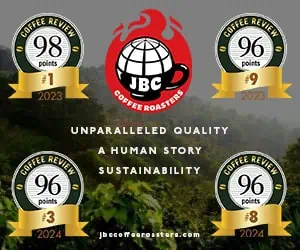LATEST REVIEWS
We have published thousands of coffee reviews and espresso reviews since 1997. The reviews below appear in reverse chronological order by review date. Older reviews may no longer accurately reflect current versions of the same coffee. To search for a specific roaster, origin or coffee use the Advanced Search Function.
An interesting coffee that provoked a wide range of reaction. Everyone agreed that it was a soft coffee with medium body. The controversy centered on the flavor complex at the heart of the profile, which elicited characterizations ranging from "delightfully spicy" and "richly chocolaty" to "harsh, burned and disturbing" and "burned seaweed, or something I had in a sushi bar(!)." Scores also varied wildly. The nays didn't outnumber the yeas, but the naysayers nayed with more conviction than the yeasayers yeaed, culminating in a low average score. Readers who like low-acid profiles may want to try this coffee anyhow. At a moderately dark brown or full-city roast I suspect the controversial flavor complex will lose its slightly hard edge and turn definitively complex and rich.
To say this coffee has an atypical profile for a Hawaii coffee is an understatement. Comparing it to the other coffees in the cupping is worse than comparing apples and oranges - more like comparing apples and cocker spaniels. The Kaanapali dry-process Moka is, as one panelist called it, a "Yemen wannabe." The trees that produced it are Yemen varietals, and the coffee has been processed in the simple, put-it-out-in-the-sun-to-dry approach used in Yemen and parts of Ethiopia. Which means that, like a Yemen or dry-processed Ethiopia, it is fruity, winy, complex, with a disturbingly lush, overripe aftertaste that lovers of these coffees call gamy or wild and people who don't like Yemen or dry-processed Ethiopia coffees call fermented.Five panelists labeled this coffee fermented and dismissed it with very low scores; three recognized the Yemen/Ethiopia characteristics and treated it like a middle-of-the-road dry-processed Yemen/Ethiopia coffee, giving it scores in the high seventies. Four didn't call it anything but gave it low scores.If this coffee had been presented to the panel in the context of similar dry-processed coffees from Yemen or Ethiopia I don't think it would have provoked quite the same level of criticism. For this reason we're not publishing its scores. However, it did not fare well in the context of this particular cupping.
The first of four Konas with identical scores of 79 and very similar flavor profiles. Overall assessments of this sample ranged from bland on the downside to balanced on the upside. Which side of the bland/balanced divide panelists settled on probably depended on their predispositions in regard to the Kona profile generally. Three panelists, including me, detected subtle but pleasant wine tones. Three called the acidity sweet, which I assume was praise as well as description. No taints or defects cited; consensus on body: medium.
Still another solid, deep Sumatra, but lacking range or dimension. Clean, one-dimensional, with little resonance in the heart of the coffee or shimmer around the edges. The aromatics seemed a bit tired; perhaps the problem here is a loss of aromatics in shipping.
Another heavy-centered Sumatra, this one with hints of sweetness and vanilla all but buried under an herby, earthy character. The earthiness is rough but rather pleasant, with only the barest hint of hardness.
An interesting but atypical Sumatra profile: Distinctly, almost distractingly sweet vanilla tones float over the Sumatra depth, which you only sense through a kind of echo. Perfumy, at turns suggesting flowers and then nuts, the vanilla notes may be too intense for elegance, lingering straight into the aftertaste, where they turn slightly cloying.
A darkish roast style asserts itself here, turning the heavy Sumatra center distinctly pungent. A slight sweetness emerges in the finish, but the mildly astringent pungency dominates in the aftertaste. A vibrant aliveness in the center of this coffee is its most attractive feature.
Herbal, pungent tones, a bit too sharp for earthy, dominate the profile, reverberating in its characteristically solid Sumatra heart. Only a touch of sweet nuance, but the herbal tones are intriguing. They turn slightly hard as the coffee cools.
Another Sumatra carried to a dark roast with enough tact to avoid carbon. But, alas, not enought to save the sweetness and nuance. What's left is a balanced dry heaviness that can be read as richness.
Another typically full-bodied, solid-centered Sumatra. Not much range or complexity, but good development: If you stay with the coffee the heaviness at the center seems to grow in weight and power, revealing reticent pruny, sweet-pungent tones in the finish. As it cools, the herby, earthy tones characteristic of some Sumatras emerge, carrying (perhaps) a hint of hardness. Without that hint I would have rated this Sumatra higher.
The dark roast style leans toward carbon here but remains on the flavorful side of it, turning the Sumatra richness pungent and darkening the sweet tones with hints of what a publicist might call chocolate. If this coffee had showed some development I would have rated it higher, but the profile made its statement and stood pat from there. As with the other Café d'Alma coffees in the cupping, I suspect a loss of aromatics in shipping.
Low-toned, full-bodied, absolutely solid at the center (maybe too), with slight hints of fruit and sweetness at the edges. In other words, a typical Sumatra. Would be a classic Sumatra if there were something more going on inside that center or a little more shimmer or lift around those edges. As it is, substantial, satisfying, but a touch inert.
An understated sweet liveliness lifts the rather stolid heart of this coffee. I can't cite any grace notes, simply a very pleasant, sweet lift. Good dimension, but (for a Sumatra) a rather shallow bottom.
Another solid, heavy-centered Sumatra. Here, however, the dark center reveals hints of wine and a character more complexly pungent than sweet. The pungency is free of earthy or hard notes, and reads as the very quintessence of rich.
Not entirely typical for a Sumatra, but something of a revelation: an almost Latin-American brightness up front before the deep Sumatra tones prevail, pulling us down into a broad, deep, sweet vanilla-tinged center. An amazing range, from the fleeting floral top notes to a pungently rich bottom, plus a long, satisfying development that carries straight through to the vanilla memories in the aftertaste.
It wasn't entirely clear whether it was a thin, attenuated quality that put this semi-dry-processed coffee near the bottom of the cupping (three reviewers explicitly used the word "thin"), or an off-taste too subtle to be called a defect but unpleasant nonetheless. I called it a "baggy hardness"; three other panelists also used the word "hard" to describe it; others used close synonyms like harsh and bitter. On the positive side, several praised this coffee's sweetness.
Perhaps this coffee was betrayed by our sample roasting. Four of ten reviewers mentioned burned or smoky tastes that may have been owing to a rushed or overdeveloped roast. Two identified a fault that may be associated with the coffee and not the roast -- a slightly medicinal or harsh character. No grace notes were cited, although the term "soft" came up frequently as usual. I was definitely in the minority with this coffee: I felt it required patience, but developed nicely: "At first heavy but nondescript, but then a gentle, light, levitating sweetness dances off the top," I wrote.
"Clean, monolithic," one cupper wrote. "OK but same old same," wrote another. One of four coffees in the cupping for which no faults whatsoever were cited; on the other hand, this carefully prepared coffee elicited only mild praise. The acidity was predictably characterized as "soft" (five of ten reviewers). Words like sweet and caramelly popped up occasionally. Only one reviewer actually effused: "chocolaty and sweet; nutty flavor."
Although this dry-processed coffee scored roughly the same as the three preceding samples, reviewers' comments seemed to indicate a coffee with more character and development. No faults or weaknesses were noted, and a tone of quiet respect ran through the few comments on flavor and aftertaste: "smooth - mellow"; "very pleasing." A split vote on body: about half the reviewers who commented found it heavy, and about half thin or light.
"Yes! This is a coffee for non-believers. This sample will convert the pagans," wrote one reviewer, apparently a supporter of Brazil coffees. Well, most of the pagans stayed unconverted, still groveling about before their acidy Central-American idols. The usual vanilla and nut tones were noted approvingly in the aroma, the soft sweetness of the acidity observed, but little enthusiasm emerged in the categories of body, flavor or aftertaste. "Not much depth," complained one. "Very uniform throughout the range in all taste aspects," remarked another carefully, "not lacking anything in particular, yet not exceeding in any category either." Three reviewers noted mild faults, two with a forest products theme: "papery; wet cardboard," said one; "woody" complained the other.











